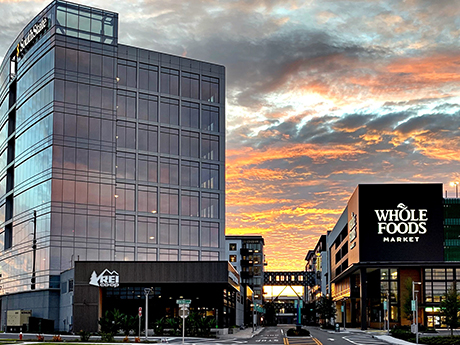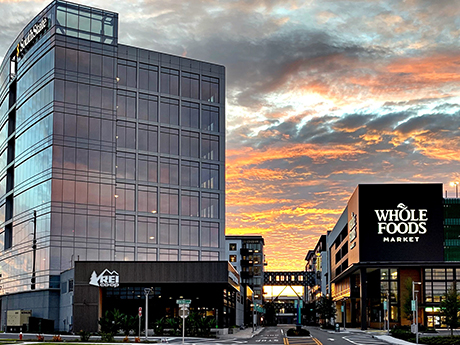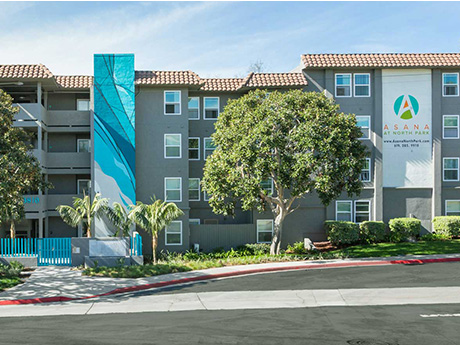Amazon recently reconfigured and consolidated its network of warehouses, and many other retailers followed suit. The result? The outlook for industrial real estate, particularly retail warehouses, is now more difficult to interpret. Many retail clients are repositioning their supply chains to help avoid slowdowns and a potential International Warehouse Logistics Association (IWLA) union strike on the West Coast. This change has merged with a corporate need to find additional options for shipping and transport (especially as prices for transportation and industrial rents rise). The demand for industrial space has increased rapidly in less “congested” areas. As economic uncertainty continues, there is a shift towards tertiary markets for industrial real estate. This change provides significant opportunities for industrial investors, says Steve Pastor, VP of global supply chain, and ports/rail logistics/consultant at NAI James E. Hanson, who serves as NAI Global Industrial Council Chair. Investors and developers may be able to take advantage of a pause in a highly competitive field, in tertiary markets that have been traditionally less expensive than major and core markets. Amazon’s Impact News of Amazon’s plans to scale back its acquisition of industrial space (and to sublease its existing property to other retailers) has given some users opportunities …
Features
Seniors Housing Operators See Rapid Rise in Online Leads and Universal Workers, Say InterFace Panelists
by John Nelson
By John Nelson ATLANTA — Property managers rely on various tools and methods to boost occupancy at their seniors housing facilities. One common avenue is for operators to have reliable online lead generators that connect their sales teams to potential residents and their families. Digital platforms in the seniors housing space like A Place for Mom and Grow Your Occupancy are churning out such leads for sales teams, and operators are saying that it’s a double-edged sword because they are coming in at a rapid clip. “We love the leads but we have one salesperson per community typically,” said Don Bishop, CEO of Tallahassee, Fla.-based SRI Management. “The response time is important. Some leads take a long time to prospect and work through the system. Having too many leads is a good challenge, but it is a challenge.” Bishop’s comments came during the operations panel at the ninth annual InterFace Seniors Housing Southeast, a networking and information conference hosted by France Media’s InterFace Conference Group and Seniors Housing Business. The event was held Wednesday, Aug. 17 at the Westin Buckhead hotel in Atlanta. Pilar Carvajal, founder and CEO of Innovation Senior Living, said that her firm has been discussing creative …
Content PartnerFeaturesLeasing ActivityLoansMidwestMultifamilyNortheastSoutheastTexasWalker & DunlopWestern
How to Maintain Multifamily Investment Momentum in the Face of Rising Interest Rates
By Melissa Jahnke, associate director of operations, Walker & Dunlop The Federal Reserve raised interest rates by 75 basis points in June and then another 75 basis points in July, sending shockwaves across the commercial real estate industry. Fortunately, there are opportunities and solutions to bypass these potential roadblocks. Specifically, investors in a segment of multifamily housing known as small balance lending (SBL), encompassing five- to 150-unit properties, have several options to realize their aspirations for financing multifamily portfolios. View a higher resolution version of the timeline above here. During a recent webcast “Financing Amid Rising Rates: Best Approaches for $1M-$15M Multifamily Loans,” Walker & Dunlop’s market experts spoke about navigating today’s financing landscape. The expert panel included Allison Williams, senior vice president and chief production officer; Allison Herrera, senior director of SBL; and Tim Cotter, director of capital markets. These experienced professionals have found ways to make deals happen in a wide variety of financing environments and have shared their perspectives and guidance. If you are an owner of five- to 150-unit properties that require loans between $1 million to $15 million, the following will help you navigate today’s financial environment and build your momentum. Step 1: Consider the …
By Kristin Hiller The combination of a spike in material costs, disruptions in the supply chain and a lack of available workers has created a difficult building environment for general contractors. “It’s no secret that there are pressure points on our industry right now,” says Kinjal Patel, general manager and senior vice president for Lendlease Construction in Chicago. “The challenges we’ve faced the last couple years around supply chain disruption and rising materials and labor costs have only escalated, making planning and budgeting for projects incredibly unpredictable. In some cases, increases are as high as 10 percent in a span of just six months.” Despite these challenges, general contractors maintain robust pipelines and anticipate that this year’s revenues will exceed last year’s totals. “Last year, there was a lot of uncertainty as we were still in the process of rebounding from COVID, and construction deals were just finding their legs,” says Michael Meagher, president of Chicago-based McHugh Construction. “Our backlog today is better than the corresponding time a year ago as deals have continued to push forward. We forecast 2022 to be a better year for us than 2021.” Meagher anticipates that McHugh’s revenues will be more than 30 percent …
Content PartnerFeaturesIndustrialLeasing ActivityLee & AssociatesLife SciencesMidwestMultifamilyNortheastOfficeRetailSoutheastTexasWestern
Lee & Associates’ Second-Quarter 2022 Economic Rundown by Sector
Rising interest rates, inflation and general economic uncertainty altered the patterns and outlooks for the industrial, office, retail and multifamily sectors across the United States. As Lee & Associates’ recent Q2 2022 North America Market Report reveals, certain sectors like industrial and multifamily, that were white hot last year, have begun to cool slightly. Meanwhile, retail is making historic gains in the face of decreasing interest in ecommerce. The full Lee & Associates report is available (with further breakdowns of factors like vacancy rates, market rents, inventory square footage and cap rates by city) here. The analysis below provides an overview of four major commercial real estate sectors alongside economic factors impacting each. Industrial Overview: Record Low Supply, Rent Growth Demand for industrial space eased slightly from its record-setting growth of last year but remained strong through for the first half of 2022 as annualized rent growth moved into double digits and the overall vacancy rate fell to 3.9 percent, a record low. Net absorption through June totaled 192.2 million square feet. It was the second highest two-quarter total on record and more than the 170 million square feet of tenant growth for all of 2019. It was exceeded only by 297.8 …
Yardi Matrix Report: Institutions Will Own 40 Percent of All Single-Family Rentals by 2030
by Jeff Shaw
SANTA BARBARA, CALIF. — Institutional capital investment in single-family-rental (SFR) acquisitions and build-to-rent (BTR) projects is growing by leaps and bounds. Institutions funded $2.5 billion in SFR acquisitions in 2021 and committed more than $60 billion in capital to buying single-family rental homes over the past year, according to Yardi Matrix’s new report, “Build-to-Rent Fuels Growth in Institutional Single-Family Rental Market.” By 2030, Institutions are expected to own about 7.6 million homes, accounting for almost half (40 percent) of all single-family-rental units in the country. “The institutions that are getting involved in SFRs tend to be private equity funds,” says Paul Fiorilla, director of U.S. research at Yardi Matrix. “There are some traditional core investors that are getting into it, but it’s still looked at as a niche, high-yield sector.” According to Yardi Matrix, mom-and-pop owners still make up most single-family rentals, but institutions are increasing market share, with a heavy concentration in the Sun Belt. According to the National Association of Realtors, Texas (28 percent) topped the list of states with institutional buyers, followed by Georgia (19 percent), Oklahoma and Alabama (18 percent), and Mississippi (17 percent). However, with bulk and one-off home purchases becoming less attractive as options due …
By Nicholas Haines, CEO, Bromley Cos. The desire to live close to everyday retail destinations — grocery stores, restaurants, gyms — isn’t new. But demand for this type of amenity has become increasingly popular with the rise of mixed-use developments. Think about when you go on vacation. You pick a hotel or rental property that’s close to activities you want to do, sights you want to see or places you want to eat. Now, people are beginning to crave that same convenience in everyday life — and it makes sense. While the pandemic blurred the lines between living, working and playing, rental communities that include residential, office and retail space have more than doubled in demand throughout the United States just over the past decade. These units, also known as live-work-play (LWP) apartments, have seen a substantial increase in interest, especially among millennials. Walkability is one of the primary traits that millennials seek when they’re searching for residential options, and LWP apartments present a unique opportunity to blend accessibility with desirable living experiences, world-class amenities, communal green spaces and exciting restaurant, retail and entertainment options. LWP apartments have proven to be a worthy investment, but just like with any other …
By Nicholas Haines, CEO, Bromley Cos. The desire to live close to everyday retail destinations — grocery stores, restaurants, gyms — isn’t new. But demand for this type of amenity has become increasingly popular with the rise of mixed-use developments. Think about when you go on vacation. You pick a hotel or rental property that’s close to activities you want to do, sights you want to see or places you want to eat. Now, people are beginning to crave that same convenience in everyday life — and it makes sense. While the pandemic blurred the lines between living, working and playing, rental communities that include residential, office and retail space have more than doubled in demand throughout the United States over the past decade. These units, also known as live-work-play (LWP) apartments, have seen a substantial increase in interest, especially among millennials. Walkability is one of the primary traits that millennials seek when they’re searching for residential options, and LWP apartments present a unique opportunity to blend accessibility with desirable living experiences, world-class amenities, communal green spaces and exciting restaurant, retail and entertainment options. LWP apartments have proven to be worthy investments, but just like with any other development, there …
By Sarah Yaussi, vice president of business strategy, National Multifamily Housing Council What do renters want now? You might think that the latest and greatest tech upgrades would be at the top of their wish lists, or that fancy fixtures and finishes would be a powerful differentiator when choosing among their rental options. In reality, however, the most valued apartment features and community amenities for the 250,000 or so renters surveyed in the 2022 NMHC/Grace Hill Renter Preferences Survey Report were, in large part, far simpler. Those amenities and services that allowed them to simplify their to-do lists and take care of their families and their own health clocked in at the top of our list. About the Survey NMHC/Grace Hill survey respondents were asked about their levels of interest in a battery of apartment features and community amenities. Features are those design aspects contained within the unit or home itself. Amenities, on the other hand, are shared by residents of the community and most often refer to a rental community’s common areas. If respondents expressed interest, they were then asked how much more they would be willing to pay per month for an identical rental home that had that …
Proptech Improves Employee, Asset Performance While Giving Residents the Autonomy They Demand
by Jeff Shaw
By Stacey Darden, senior director of innovation and compliance, New Standard Equities In the multifamily industry, we rely on technology to increase productivity and to help us make strategic decisions. Technology allows information and data from various sources to be collected and organized in a way that is easy to understand. Rather than looking at different reports to form an educated decision, technology can help synthesize data into predictive analytics based on historical activity and current trends. Previously, decision makers, such as asset managers or investors, would review various reports only using one piece of information to try and compare findings across portfolios or regions. The old-fashioned approach might include reviewing a box score report or resident activity detail to understand property operations for a given period. Or it may have involved reviewing a variance report to understand the financial activity for a given period. An asset manager would then try to discover any correlation between the two sets of reporting. Technology can help display all given metrics in a digestible manner to easily identify if any patterns or relationships exist. Selecting a technology provider who will partner with clients and help customize reporting based on the client’s needs will …









